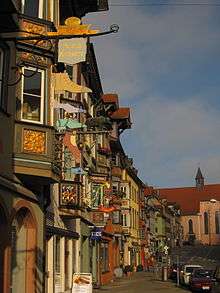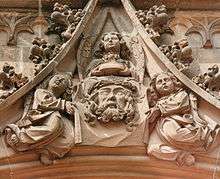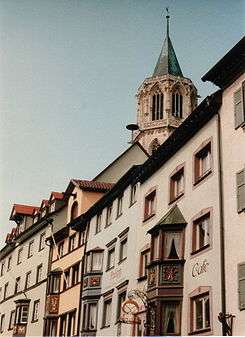Rottweil
| Rottweil | ||
|---|---|---|
|
Main street in Rottweil | ||
| ||
 Rottweil | ||
Location of Rottweil within Rottweil district 
 | ||
| Coordinates: 48°10′5″N 8°37′29″E / 48.16806°N 8.62472°ECoordinates: 48°10′5″N 8°37′29″E / 48.16806°N 8.62472°E | ||
| Country | Germany | |
| State | Baden-Württemberg | |
| Admin. region | Freiburg | |
| District | Rottweil | |
| Government | ||
| • Lord Mayor | Ralf Broß | |
| Area | ||
| • Total | 71.76 km2 (27.71 sq mi) | |
| Population (2015-12-31)[1] | ||
| • Total | 24,915 | |
| • Density | 350/km2 (900/sq mi) | |
| Time zone | CET/CEST (UTC+1/+2) | |
| Postal codes | 78628, 78652 (Unterrotenstein) | |
| Dialling codes | 0741, 07427 (Neukirch) | |
| Vehicle registration | RW | |
| Website | www.rottweil.de | |
Rottweil (/ʁɔtvaɪl/ ![]() listen ) is a town in southwest Germany in the state of Baden-Württemberg. Rottweil has been a Free Imperial City for nearly 600 years.
listen ) is a town in southwest Germany in the state of Baden-Württemberg. Rottweil has been a Free Imperial City for nearly 600 years.
Located between the Black Forest and the Swabian Alps, Rottweil has about 25,000 inhabitants. The old town is famous for its medieval center and for its traditional carnival, (called "Fasnet" in the local Swabian dialect). It's the oldest town in Baden-Württemberg[2] and its appearance has changed very little since the 16th century.


History
| Imperial City of Rottweil | ||||||||||
| Reichsstadt Rottweil | ||||||||||
| Free Imperial City of the Holy Roman Empire | ||||||||||
| ||||||||||
| Capital | Rottweil | |||||||||
| Government | Republic | |||||||||
| Historical era | Middle Ages | |||||||||
| • | Founded | AD 73 | ||||||||
| • | Gained Imp. immediacy | 1140 | ||||||||
| • | Treaty with Swiss | 1463 | ||||||||
| • | Swiss associate | 1519 | ||||||||
| • | Mediatised to Württemberg | 1802 | ||||||||
| ||||||||||
| Imperial Abbey of Rottenmünster | ||||||||||
| Reichskloster Rottenmünster | ||||||||||
| Imperial Abbey of the Holy Roman Empire | ||||||||||
| ||||||||||
| Capital | Rottenmünster | |||||||||
| Government | Principality | |||||||||
| Historical era | Middle Ages | |||||||||
| • | Founded | 9 May 1224 | ||||||||
| • | Gained Imp. immediacy | 1237 | ||||||||
| • | Razed by Württemberg in Thirty Years' War | 1643 | ||||||||
| • | Mediatised to Württemberg | 23 November 1802 | ||||||||
| • | Abbey abandoned | 1850 | ||||||||
| ||||||||||
Rottweil was founded by the Romans in AD 73 as Arae Flaviae and became a municipium, but there are traces of human settlement going back to 2000 BC. Roman baths and a mosaic of Orpheus (c. AD 180) date from the time of Roman settlement. The present town became a ducal and a royal court before 771 and in the Middle Ages it became a Free Imperial City in 1268.
In 1463 the city joined the Swiss Confederacy, with which it was closely aligned for several centuries. Both its status as free city and its alliance with the Swiss Confederacy were eventually lost with the conquest of the region by Napoleon in 1803.
Lord Mayors since the 19th century
- 1820–1833: Max Joseph von Khuon, Schultheiß
- 1833–1845: Max Teufel
- 1845–1848: Karl Dinkelmann
- 1848–1851: Kaspar Rapp
- 1852–1887: Johann Baptist Marx
- 1887–1923: Edwin Glückher
- 1924–1943: Josef Abrell
- 1943–1944: Otto Mann
- 1944–1945: Paul Fritz
- 1945–1946: Franz Mederle
- 1946–1965: Arnulf Gutknecht
- 1965–1985: Ulrich Regelmann, mayor, since 1970 Lord mayor
- 1985–2001: Michael Arnold, Lord mayor
- 2001–2009: Thomas Engeser, Lord mayor
- ab 2009: Ralf Broß, Lord mayor
Main sights
- The late-Romanesque and Gothic-era Münster Heiliges Kreuz ("Minster of the Holy Cross"), built over a pre-existing church from 1270. It features a crucifix by Veit Stoss and noteworthy Gothic sculptures.
- Kapellenkirche (1330–40), a Gothic church with a tower and with three statue-decorated portals.
- Lorenzkapelle ("Church of St. Lawrence", 16th century), in late Gothic style. It houses some two hundred works by Swabian masters and Gothic altarpieces from the 14th and 15th centuries.
- The towns museum, including a notable Roman mosaic with the legend of Orpheus.
- The late-Gothic Town Hall (1521).
- St. Pelagius, a Romanesque church from the 12th century. Excavations have brought to light Roman baths in the same site.
- ThyssenKrupp is constructing a $45 million, 807-foot tower. The tower is a research facility for the company and will be used to test new elevator cars and technologies. At 807-feet, it will be the tallest structure in the district. The windowless building is going to have 12 elevator shafts.[3]
Other
- The Rottweiler dog is named after this town; it used to be a butcher's dog in the region.
- Adam of Rottweil, the 15th-century scholar and printer, was born in Rottweil.
- Konrad Witz, painter
- Das Mädchen aus Rottweil is a song by the German band Die Toten Hosen
Sons and daughters of the town
- Egon Rieble (1925–2016), art historian and dialect poet
- Hermann Schäfer (1927–2009), composer and music scientist
- Kurt Bantle (born 1933), politician (SPD), former member of Landtag
- Ekkehard Lindner (born 1934), chemist and professor
- Sigrid Peyerimhoff (born 1937), chemist
- Erwin Teufel (born 1939), politician (CDU), former minister president of Baden-Württemberg
- Rüdiger Safranski (born 1945), writer and literary scholar
- Thomas Engeser (born 1948), 2001–2009 Lord mayor of Rottweil
- Rita Haller-Haid (born 1950), politician (SPD), Member of Landtag 2001-2016
- Anne Haigis (born 1955), musician and singer
- Bernd Marquart (born 1958), jazz musician
- Ralf Broß (born 1966), since 2. July 2009 Lord mayor of Rottweil
- Andreas Schwab (born 1973), politician (CDU) and member of European Parlament
- Joshua Kimmich (born 1995), football player (Bayern München)
International relations
Rottweil is twinned with:
See also
References
- ↑ "Gemeinden in Deutschland nach Fläche, Bevölkerung und Postleitzahl am 30.09.2016". Statistisches Bundesamt (in German). 2016.
- ↑ Website of Dominikaner Museum Rottweil (retrieved May 22, 2014), on permanent display is a wooden table from August 4, AD 186 naming arae flaviae as municipium thus making Rottweil the oldest town in Baden-Württemberg
- ↑ Brown, Eliot. "Elevators Elevate German City's Image". Wall Street Journal. ISSN 0099-9660. Retrieved 2015-10-27.
External links
| Wikimedia Commons has media related to Rottweil. |
- The official website
- Feast of Fools: Medieval Carnival Celebrations in Rottweil
- Website for hotels and restaurants in Rottweil
- History and territory of the former Reichsstadt Rottweil
- Pictures and stories about Rottweil



